简易英文读物自然小百科.挖恐龙 dinosaur hunter .挖恐龙
不同恐龙的介绍英文作文

不同恐龙的介绍英文作文Introduction to Different Dinosaurs。
Dinosaurs are a group of reptiles that lived on Earth millions of years ago. They are now extinct, but their fossils have been discovered all over the world. There were many different types of dinosaurs, each with its own unique features and characteristics. In this article, we will introduce some of the most famous dinosaurs.Tyrannosaurus Rex。
Tyrannosaurus Rex, also known as T. Rex, was one of the largest and most fearsome dinosaurs that ever lived. It was a carnivorous dinosaur that lived in North America during the late Cretaceous period, about 68 to 66 million years ago. T. Rex had a large head with powerful jaws and sharp teeth. It was also very strong and could run at a speed of up to 20 miles per hour.Stegosaurus。
Stegosaurus was a herbivorous dinosaur that lived in North America during the late Jurassic period, about 155 to 150 million years ago. It was a large dinosaur that could grow up to 30 feet long and weigh up to 6,800 pounds. Stegosaurus had a distinctive appearance, with bony plates on its back and a spiked tail. These plates were used for defense against predators, while the spiked tail was used for offense.Velociraptor。
一种恐龙介绍英文作文
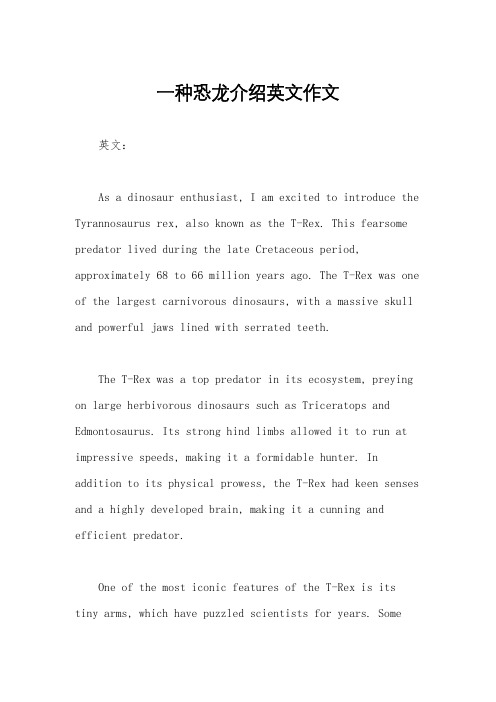
一种恐龙介绍英文作文英文:As a dinosaur enthusiast, I am excited to introduce the Tyrannosaurus rex, also known as the T-Rex. This fearsome predator lived during the late Cretaceous period, approximately 68 to 66 million years ago. The T-Rex was one of the largest carnivorous dinosaurs, with a massive skull and powerful jaws lined with serrated teeth.The T-Rex was a top predator in its ecosystem, preying on large herbivorous dinosaurs such as Triceratops and Edmontosaurus. Its strong hind limbs allowed it to run at impressive speeds, making it a formidable hunter. In addition to its physical prowess, the T-Rex had keen senses and a highly developed brain, making it a cunning and efficient predator.One of the most iconic features of the T-Rex is itstiny arms, which have puzzled scientists for years. Sometheories suggest that these arms may have been used for grasping onto mates during mating rituals, while others believe they may have had a functional purpose in hunting or feeding. Regardless of their function, the T-Rex's arms are a distinctive characteristic that sets it apart from other dinosaurs.Despite its fearsome reputation, the T-Rex may have had a more complex social structure than previously thought. Fossil evidence suggests that T-Rex juveniles may have formed social groups, similar to modern-day predators like lions. This challenges the traditional view of the T-Rex as a solitary hunter and raises questions about its behavior and interactions with other members of its species.In popular culture, the T-Rex is often depicted as a roaring, rampaging monster, thanks to its portrayal in movies like "Jurassic Park." However, scientists believe that the T-Rex may have had a more bird-like vocalization, similar to the sound of a low-frequency roar or rumble. This more nuanced understanding of the T-Rex'svocalizations adds to its mystique and makes it even morefascinating to dinosaur enthusiasts like myself.Overall, the T-Rex is a captivating and enigmatic creature that continues to capture the imagination of people around the world. Its imposing size, powerful jaws, and distinctive features make it a truly iconic dinosaur that will forever hold a special place in the hearts of dinosaur enthusiasts.中文:作为一个恐龙爱好者,我非常兴奋地介绍霸王龙,也被称为T-Rex。
英语恐龙手抄报内容
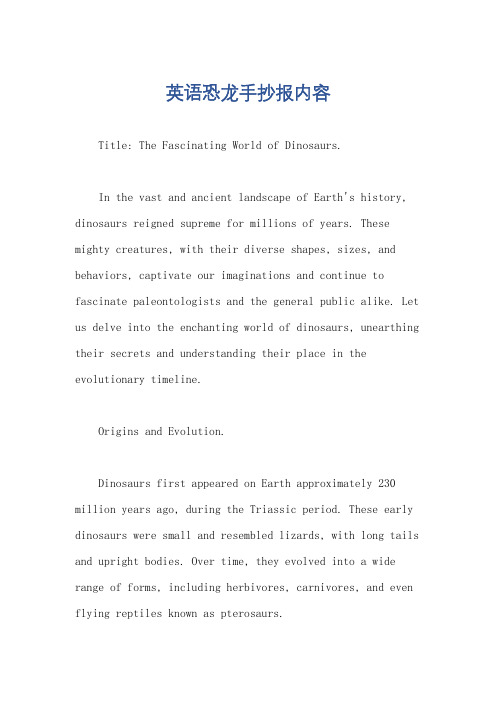
英语恐龙手抄报内容Title: The Fascinating World of Dinosaurs.In the vast and ancient landscape of Earth's history, dinosaurs reigned supreme for millions of years. These mighty creatures, with their diverse shapes, sizes, and behaviors, captivate our imaginations and continue to fascinate paleontologists and the general public alike. Let us delve into the enchanting world of dinosaurs, unearthing their secrets and understanding their place in the evolutionary timeline.Origins and Evolution.Dinosaurs first appeared on Earth approximately 230 million years ago, during the Triassic period. These early dinosaurs were small and resembled lizards, with long tails and upright bodies. Over time, they evolved into a wide range of forms, including herbivores, carnivores, and even flying reptiles known as pterosaurs.The Jurassic period marked a significant era of dinosaur evolution, with the emergence of giants like theT-Rex and the Sauropods. These dinosaurs were giants compared to their predecessors, with the Sauropods growing to lengths of up to 100 feet and weighing as much as 80 tons.The Cretaceous period saw the diversification of dinosaurs, with over 1,000 species coexisting. This period also marked the appearance of birds, which are considered direct descendants of dinosaurs.Diversity and Classification.Dinosaurs were classified into two main groups: Ornithischia and Sauropsida. Ornithischia, or "bird-hipped" dinosaurs, included herbivores like the Triceratops and the Ankylosaurus, which were armored with thick plates and spikes. Sauropsida, or "lizard-hipped" dinosaurs, encompassed a wide range of species, from carnivores like the Allosaurus and the Tyrannosaurus Rex to herbivores likethe Brachiosaurus and the Argentinosaurus.Flying dinosaurs, known as pterosaurs, were also a unique class of dinosaurs. These reptiles had wingsspanning up to 35 feet and glided or fluttered through the air, hunting insects and small vertebrates.Ecosystem and Habitat.Dinosaurs inhabited a diverse range of habitats, from deserts to swamps and from forests to tundra. They were adapted to their environments in various ways, with some species developing thick coats to withstand cold climates, while others evolved hollow bones to help them float in water.Dinosaurs formed complex ecosystems, with herbivores grazing on plants and carnivores preying on weaker animals. This predator-prey relationship kept the ecosystem in balance, ensuring the survival of various species.Extinction.Approximately 66 million years ago, dinosaurs met their fate in a cataclysmic event known as the Cretaceous-Paleogene extinction. Theories abound regarding the cause of this extinction, ranging from volcanic eruptions to asteroid impacts. The most popular theory suggests that a large asteroid hit Earth, causing widespread fires, dust clouds that blocked out the sun, and climate changes that led to the dinosaurs' demise.Conclusion.The dinosaurs' story is a fascinating chapter inEarth's history. Their diversity, adaptability, and the mystery surrounding their extinction continue to captivate us. As we delve deeper into the secrets of these ancient giants, we gain a better understanding of our own place in the evolutionary timeline. The dinosaurs' legacy lives onin the form of birds and their influence on modern ecosystems, reminding us of the profound impact they had on our planet.This brief overview of dinosaurs scratches the surface of their rich history and biology. To fully appreciate their fascinating world, one must delve deeper into the research and discoveries of paleontologists. The study of dinosaurs continues to offer insights into the past and inspire us to explore the mysteries of the natural world.。
恐龙简介(中英文)
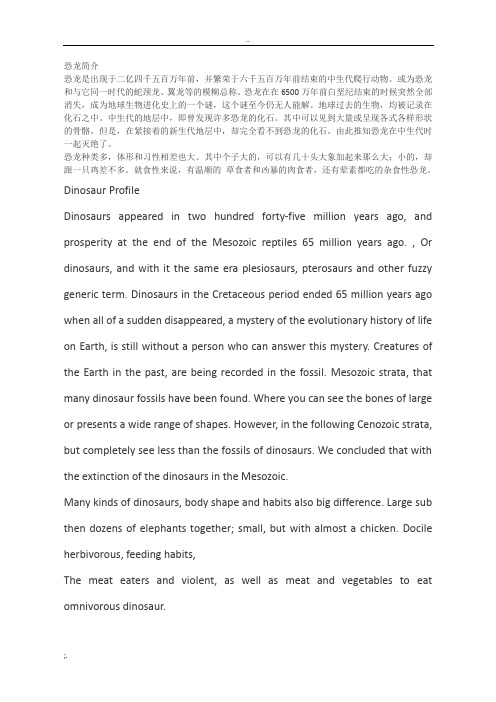
恐龙简介恐龙是出现于二亿四千五百万年前,并繁荣于六千五百万年前结束的中生代爬行动物。
或为恐龙和与它同一时代的蛇颈龙、翼龙等的模糊总称。
恐龙在在6500万年前白垩纪结束的时候突然全部消失,成为地球生物进化史上的一个谜,这个谜至今仍无人能解。
地球过去的生物,均被记录在化石之中。
中生代的地层中,即曾发现许多恐龙的化石。
其中可以见到大量或呈现各式各样形状的骨骼。
但是,在紧接着的新生代地层中,却完全看不到恐龙的化石。
由此推知恐龙在中生代时一起灭绝了。
恐龙种类多,体形和习性相差也大。
其中个子大的,可以有几十头大象加起来那么大;小的,却跟一只鸡差不多。
就食性来说,有温顺的草食者和凶暴的肉食者,还有荤素都吃的杂食性恐龙。
Dinosaur ProfileDinosaurs appeared in two hundred forty-five million years ago, and prosperity at the end of the Mesozoic reptiles 65 million years ago. , Or dinosaurs, and with it the same era plesiosaurs, pterosaurs and other fuzzy generic term. Dinosaurs in the Cretaceous period ended 65 million years ago when all of a sudden disappeared, a mystery of the evolutionary history of life on Earth, is still without a person who can answer this mystery. Creatures of the Earth in the past, are being recorded in the fossil. Mesozoic strata, that many dinosaur fossils have been found. Where you can see the bones of large or presents a wide range of shapes. However, in the following Cenozoic strata, but completely see less than the fossils of dinosaurs. We concluded that with the extinction of the dinosaurs in the Mesozoic.Many kinds of dinosaurs, body shape and habits also big difference. Large sub then dozens of elephants together; small, but with almost a chicken. Docile herbivorous, feeding habits,The meat eaters and violent, as well as meat and vegetables to eat omnivorous dinosaur.Dinosaurs,one of the most successful groups of animals (in terms of longevity) that have ever lived,evolved into many diverse sizes and shapes,with many equally diverse modes of living.The term "Dinosauria" was invented by Sir Richard Owen in 1842 to describe these "fearfully great reptiles," specifically Megalosaurus,Iguanodon,and Hylaeosaurus,the only three dinosaurs known at the time.The creatures that we normally think of as dinosaurs lived during the Mesozoic Era,from late in the Triassic period (about 225 million years ago) until the end of the Cretaceous (about 65 million years ago).But we now know that they actually live on today as the birds.Some things to keep in mind about dinosaurs:•Not everything big and dead is a dinosaur.All too often,books written (or movies made) for a popular audience include animals such as mammoths,mastodons,pterosaurs,plesiosaurs,ichthyosaurs,and the sail-backed Dimetrodon.Dinosaurs are a specific subgroup of the archosaurs,a group that also includes crocodiles,pterosaurs,and birds.although pterosaurs are close relations,they are not true dinosaurs.Even more distantly related to dinosaurs are the marine reptiles,which include the plesiosaurs and ichthyosaurs.Mammoths and mastodons are mammals and did not appear until many millions of years after the close of the Cretaceous period.Dimetrodon is neither a reptile nor a mammal,but a basal synapsid,i.e.,an early relative of theancestors of mammals.•Not all dinosaurs lived at the same time.Different dinosaurs lived at different times.Despite the portrayals in movies like King Kong and Jurassic Park,no Stegosaurus ever saw a Tyrannosaurus,because Tyrannosaurus didn't appear on the scene until 80 or so million years following the extinction of stegosaurs.The same goes for Apatosaurus ("Brontosaurus") —it's bones were already well-fossilized by the time T.rex came along.•Dinosaurs are not extinct.Technically.Based on features of the skeleton,most people studying dinosaurs consider birds to be dinosaurs.This shocking realization makes even the smallest hummingbird a legitimate dinosaur.So rather than refer to "dinosaurs" and birds as discrete,separate groups,it is best to refer to the traditional,extinct animals as "non-avian dinosaurs" and birds as,well,birds,or "avian dinosaurs." It is incorrect to say that dinosaurs are extinct,because they have left living descendants in the form of cockatoos,cassowaries,and their pals —just like modern vertebrates are still vertebrates even though their Cambrian ancestors are long extinct.。
恐龙百科(Dinosaur encyclopedia)

恐龙百科(Dinosaur encyclopedia)早白垩世---早白垩世--始初龙(始盗龙)美丽龙(克拉美丽龙)异特龙(异特龙)西风龙(西风龙)棱齿龙(稜齿龙)禽龙(禽龙)穆塔布拉龙(木他龙)无畏龙(悍龙)马鬃龙(马鬃龙)高吻龙(高吻龙)南阳龙(Nanyangosaurus)沉龙(沉龙)康纳龙(Kangnasaurus)荒漠龙(荒漠龙)福井龙(福井龙)锦州龙(Jinzhousaurus)腱龙(腱龙)原巴克龙(原巴克龙)恐龙雷利诺龙(雷利诺龙)阿特拉斯科普柯龙(Atlascopcosaurus)丝路龙(丝路龙)快达龙(快达龙)闪电兽龙(闪电兽龙)热河龙(热河龙)孔椎龙(孔椎龙)宣化龙(xuanhuasaurus)狭盘龙(狭盘龙)祖尼角龙(祖尼角龙)古角龙(古角龙)朝阳龙(朝阳龙)辽宁角龙(Liaoceratops)红山龙(红山龙)乌尔禾龙(乌尔禾龙)胜山龙(katsuyamakensaurus)查干诺尔龙(诺尔龙)约巴龙(Jobaria)极龙(巨龙)亚洲龙(Asiatosaurus)奥古斯丁龙(奥古斯丁龙)蒙古龙(蒙古龙)尼日尔龙(Nigersaurus)伊斯的利亚龙(Histriasaurus)雷尤守龙(雷尤守龙)雷巴齐斯龙(雷巴齐斯龙)利迈河龙(Limaysaurus)阿马加龙(阿马加龙)亚马逊龙(亚马逊龙)釜庆龙(釜庆龙)江山龙(Jiangshanosaurus)软骨龙(Chondrosteosaurus)阿拉果龙(Aragosaurus)畸形龙(Pelorosaurus)澳洲南方龙(Austrosaurus)鸟面龙(鸟面龙)毒瘾龙(Venenosaurus)星牙龙(星牙龙)优腔龙(优腔龙)侧空龙(侧空龙)索诺拉龙(索诺拉龙)波塞东龙(为)雪松龙(雪松龙)高龙(高龙)阿尔哥龙(Algoasaurus)齐碎龙(齐碎龙)朱特龙(朱特龙)丘布特龙(丘布特龙)大尾龙(大尾龙)怪味龙(Tangvayosaurus)布万龙(布万龙)潮汐龙(罗氏)戈壁巨龙(戈壁巨龙)安第斯龙(安第斯龙)白垩纪时期复原图马拉维龙 (malawisaurus) 顶棘龙 (altispinax) 簧椎龙(calamospondylus) 首都龙 (capitalsaurus) 恩巴龙 (embasaurus) 阴龙 (inosaurus) 加贺龙 (kagasaurus) 胜山龙(katsuyamasaurus) 秋田龙 (wakinosaurus) 沃格特鳄龙(walgettosuchus) 克拉玛依龙 (kelmayisaurus) 原恐齿龙(prodeinodon) 棘椎龙 (spinostropheus) 小力加布龙(ligabueino) 比克尔斯棘龙 (becklespinax) 威尔顿盗龙(valdoraptor) 挺足龙 (erectopus) 非洲猎龙 (afrovenator) 吐谷鲁龙 (tugulusaurus) 暹罗龙 (siamosaurus) 脊饰龙(cristatusaurus) 重爪龙 (baryonyx) 似鳄龙 (suchomimus) 激龙(irritator) 崇高龙 (angaturama) 福井盗龙 (fukuiraptor) 高棘龙 (acrocanthosaurus) 矮异特龙 (dwar fallosaur) 新猎龙(neovenator) 鲨齿龙 (carcharodontosaurus) 南方巨兽龙(giganotosaurus) 巴哈利亚龙 (bahariasaurus) 吉兰泰龙(chilantaisaurus) 簧龙 (calamosaurus) 似菊娜鸟龙(ginnareemimus) 似鸟身女妖龙 (harpymimus) 七镇鸟龙(heptasteornis) 敏捷龙 (phaedrolosaurus) 彩蛇龙 (kakuru) 阿肯色龙 (arkansaurus) 恩霹渥巴龙 (nqwebasaurus) 内德科尔伯特龙 (nedcolbertia) 桑塔纳盗龙 (santanaraptor) 棒爪龙(scipionyx) 雅尔龙 (yaverlandia) 极鳄龙 (aristosuchus) 中华龙鸟 (sinosauropteryx) 华夏颌龙 (huaxiagnathus) 寐龙 (mei)小坐骨龙 (mirischia) 原始祖鸟 (protarchaeopteryx) 似提姆龙(timimus) 义县龙 (yixianosaurus) 小猎龙 (microvenat or) 尾羽龙 (caudipteryx) 小盗龙 (microraptor) 顾氏小盗龙 (m.GUI) (Sinornithosaurus) Chinese Oulung dilon (Dilong) eotyrannus (Eotyrannus) Siam Raptors (Siamotyrannus) tonouchisaurus (Tonouchisaurus) China ornithopod (Sinornithoides) China lielong (Sinovenator) Dou Bilong (Sinusonasus) Archaeornithomimus (Archaeornithomimus) shengzhoulong (Shenzhousaurus) dragon hill (Sanchusaurus) as pelecanimimus (Pelecanimimus) incisivosaurus (Incisivosaurus) rapator (Rapator) ornithodesmus (Ornithodesmus) Utah rapator (Utahraptor) baryony (Deinonychus) graciliraptor(Graciliraptor) Alashan Dragon (Alxasaurus) Argiris Ron (Achillobator) Beipiao Dragon (Beipiaosaurus) protopteryx (Protopteryx) (Unenlagia) nearly half bird bird (Anchiornis) the late Cretaceous carnivorous dragon ---Late Cretaceous--- (Carnosaurus) coeluroides (Coeluroides) Mifunesaurus (Mifunesaurus) Newton quilmesaurus Dragon (Newtonsaurus) (Quilmesaurus) (Sidormimus) to Xidelong sigilmassasaurus (Sigilmassasaurus) tsuchikurasaurus (Tsuchikurasaurus) genusaurus (Genusaurus) compsosuchus (Compsosuchus) dryptosauroides (Dryptosauroides) sharp jaws Dragon (Genyodectes) Jabbar Poole Ron (Jubbulpuria) (dragon shaped like a bird Ornithomimoides (Ilokelesia)) ilokelesia laevisuchus (Laevisuchus) rugops (Rugops) northwest of Argentina dragon dragon (Noasaurus) (Masiakasaurus) (Velocisaurus) Athlon Velociraptor (Velociraptor) mi champsosaurus (Betasuchus) Guai Huailong (Xenotarsosaurus) Kobita Haas Cron (Tarascosaurus) India champsosaurus (Indosuchus) Abe Liron (Abelisaurus) majungasaurus (Majungasaurus) Okaron (Aucasaurus) carnotaurus (Carnotaurus) India (Dragon I Ndosaurus) orthogoniosaurus (Orthogoniosaurus) Ma Jun Sheng Wang Long (Majungatholus) skull Dragon (Rajasaurus) U Quello Ron (Unquillosaurus) Spinosaurus (Spinosaurus) deltadromeus (Deltadromeus) Anne Co Ron (Aniksosaurus) microvenator (Bagaraatan) archaeornithoides (Archaeornithoides) bradycneme (Bradycneme) two (Diplotomodon chisel tooth dragon elopteryx) (Elopteryx) Yu Xia Dragon (Labocania) Richard East J Ron (Ricardoestesia) euronychodon (Euronychodon) paronychodon (Paronychodon) Ni Niaolong (Avimimus) Troodon (Dryptosaurus) Shanyang Dragon (Shanyangosaurus) rahonavis (Rahonavis) Chiba Dragon (Futabasaurus) itemirus (Itemirus) alectrosaurus(Alectrosaurus) diamond export the Dragon (Chingkankousaurus) deinodon (Deinodon) branch of the Dragon (Alioramus) and Alberto (Dragon Albert Saurus) gorgosaurus (Gorgosaurus) aublysodon (Aublysodon) nanotyrannus (Nanotyrannus) dark dragon vein (Stygivenator) dinotyrannus megagracilis (Dinotyrannus) Shan Shanlong (Shanshanosaurus) fear Dragon (Daspletosaurus) Tyrannosaurus Rex (Tyrannosaurus) (T.rex) (Tarbosaurus) Luanchuan Tarbosaurus Tarbosaurus (T.luanchuanensis)阿劳干盗龙(Araucanoraptor)无聊龙(无聊龙)鸵鸟龙(鸵鸟龙)拜伦龙(拜伦龙)蜥鸟龙(蜥鸟龙)伤齿龙(Troodon)细爪龙(stenonychosaurus)恐手龙(Deinocheirus)似奥克龙(似奥克龙)似金翅鸟龙(Garudimimus)似鸡龙(似鸡龙)似鹅龙(似鹅龙)似鸸鹋龙(dromiceiomimus)似鸟龙(似鸟龙)似鸵龙(似鸵龙)中国似鸟龙(中国似鸟龙)天青石龙(天青石龙)河源龙(Heyuannia)近颌龙(近颌龙科)亚洲近颌龙(亚洲近颌龙)纤手龙(纤手龙)单足龙(单足龙)葬火龙(citipati)窃螺龙(窃螺龙)雌驼龙(英根亚)可汗龙(Khaan)窃蛋龙(龙)阿瓦拉慈龙(alvarezsaurus)巴塔哥尼亚爪龙(Patagonykus)单爪龙(单爪龙)小驰龙(小驰龙)鸟面龙(鸟面龙)阿基里斯龙(阿基里斯龙)恶灵龙(恶灵龙)斑比盗龙(斑比盗龙)朝鲜龙(Koreanosaurus)大盗龙(大盗龙)火盗龙(火盗龙)瓦尔盗龙(瓦尔盗龙)野蛮盗龙(野蛮盗龙)驰龙(驰龙)一些恐龙拥有羽毛,如斑比盗龙。
简易英文读物自然小百科.挖恐龙 dinosaur hunter .石头说话
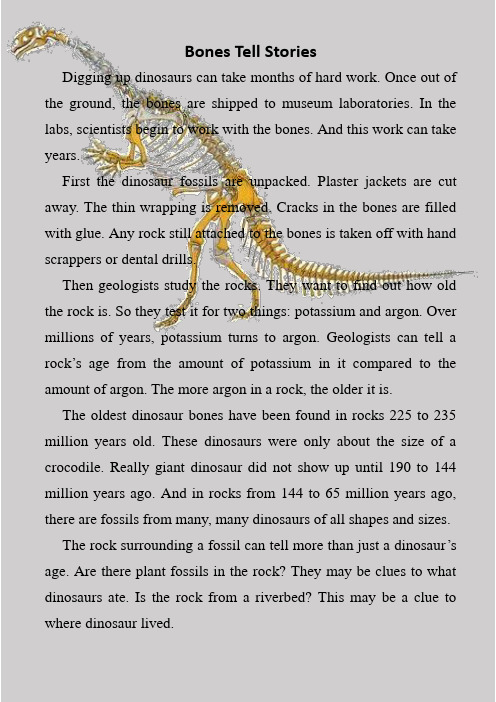
Bones Tell StoriesDigging up dinosaurs can take months of hard work. Once out of the ground, the bones are shipped to museum laboratories. In the labs, scientists begin to work with the bones. And this work can take years.First the dinosaur fossils are unpacked. Plaster jackets are cut away. The thin wrapping is removed. Cracks in the bones are filled with glue. Any rock still attached to the bones is taken off with hand scrappers or dental drills.Then geologists study the rocks. They want to find out how old the rock is. So they test it for two things: potassium and argon. Over millions of years, potassium turns to argon. Geologists can tell a rock’s age from the amount of potassium in it compared to the amount of argon. The more argon in a rock, the older it is.The oldest dinosaur bones have been found in rocks 225 to 235 million years old. These dinosaurs were only about the size of a crocodile. Really giant dinosaur did not show up until 190 to 144 million years ago. And in rocks from 144 to 65 million years ago, there are fossils from many, many dinosaurs of all shapes and sizes.The rock surrounding a fossil can tell more than just a dinosaur’s age. Are there plant fossils in the rock? They may be clues to what dinosaurs ate. Is the rock from a riverbed? This may be a clue to where dinosaur lived.Paleontologists also study the rocks. First, they look at photographs from the dig. The way bones are arranged can tell a story.Hundreds of skeletons of a small, bird-like dinosaur called Coelophysis (see-luh-FY-sis) were found together at a dig in New Mexico. This led paleontologists to think that Coelophysis travelled in packs. It also led them to think that these dinosaurs may have been caught in a flood and drowned.Eventually, all the rock around the fossils is removed. Noe paleontologists work on the fossils themselves. Sometimes they gather all the bones they think are from the same dinosaur. They lay them out on a huge, boxlike table. Then they try to put the bones together like a giant skeleton jigsaw puzzle.Once the skeleton puzzle is put together, paleontologists look for clues. What do the bones tell about the dinosaur?Are a dinosaur’s front leg much shorter than its back legs? If so, it probably walked on its hind legs, like Tyrannosaurus.Are the leg bones thick and all about the same size? Then the dinosaur probably walked on all fours, like Argentinosaurus.Paleontologists look for anything odd about the skeleton that could tell them about the dinosaur. The duck-billed Corythosaurus has a bony crest on its skull. The crest is connected to the dinosaur’s nasal passage. The nasal passage is shaped sort of likea tube or a trombone. So some paleontologists believe Corythosaurus Could make trumpeting sounds. Each type of crested duck-billed dinosaur has a different shape nasal passage. This means each type would make its own kind of “music”.Finding new fossils can change what dinosaur hunters thought they knew about dinosaurs. For almost twenty years, Majungatholus was thought to be a plant-eater. Then dinosaur hunter Dr. Cathy Forster went on a dig in Madagascar. She and the rest of the crew dug up a Majungatholus skull. It was in excellent shape. It showed something no other skull had showed. This dinosaur had small, sharp teeth. This meant Majungatholus was really a meat-eater.Paleontologists think that the bones of only one dinosaur out of every million that lived became fossils. But bones are not the only story-tellers. Fossilized dinosaur droppings, called coprolites, can give clues to how dinosaurs lived. Dinosaur hunters found what they believe is a Tyrannosaurus dropping. It is nearly three feet long and weighs over twenty pounds. Inside the coprolite they found chewed up bones from a plant-eater.Fossil footprints can also show what certain dinosaurs were doing on a certain day millions of years ago. In Texas, some footprints of Pleurocoelus, a water-loving plant-eater, were found in a riverbed. Nearby, the tracks of a fierce meat-eater, Acrocanthosaurus, appear in the mud. Was Acrocanthosaurus chasing Pleurocoelus? Nobodyknows for sure, but it looks that way. The footprints go on. Suddenly, they stop. Did Acrocanthosaurus catch its prey? Or did Pleurocoelus escape? So far, no one has been able to tell.Most fossils that are found belonged to adult dinosaurs. Their bones were big and heavy. Their teeth were large. They were more likely to become preserved as fossils than tiny bones or teeth, or delicate eggs.Most dinosaur hunters thought that dinosaurs left their eggs on their own, the way turtles and lizards do. But a group of fossilized dinosaur nests found in Montana show that this wasn’t always true.These mud nests were about seven feet across and three feet deep. They belonged to a kind of duck-billed dinosaur. Eggs were found in a few of the nests. One also had fifteen skeletons of dinosaur babies. Newly hatched babies of this type of dinosaur are about a foot long. But these babies were three feet long.The baby dinosaurs’teeth showed that they ad been eating plants for some time. How did they get their food? Most likely their mother brought it to the nest. This means that she was taking care of her babies! This dinosaur was named Maiasaurus, which means “ggod mother lizard”.Dinosuar hunters have found many amazing fossils. So far, more than 300 different kinds of dinosaurs have been dug out ofthe ground. But some dinosaur hunters think that more than 5,000 different kinds of dinosaurs once roamed the earth. That means that dinosaur hunters still have a lot of digging to do!。
恐龙英文儿歌
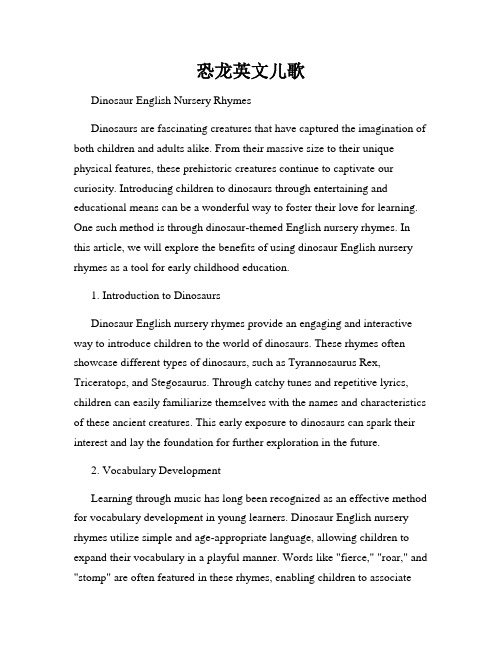
恐龙英文儿歌Dinosaur English Nursery RhymesDinosaurs are fascinating creatures that have captured the imagination of both children and adults alike. From their massive size to their unique physical features, these prehistoric creatures continue to captivate our curiosity. Introducing children to dinosaurs through entertaining and educational means can be a wonderful way to foster their love for learning. One such method is through dinosaur-themed English nursery rhymes. In this article, we will explore the benefits of using dinosaur English nursery rhymes as a tool for early childhood education.1. Introduction to DinosaursDinosaur English nursery rhymes provide an engaging and interactive way to introduce children to the world of dinosaurs. These rhymes often showcase different types of dinosaurs, such as Tyrannosaurus Rex, Triceratops, and Stegosaurus. Through catchy tunes and repetitive lyrics, children can easily familiarize themselves with the names and characteristics of these ancient creatures. This early exposure to dinosaurs can spark their interest and lay the foundation for further exploration in the future.2. Vocabulary DevelopmentLearning through music has long been recognized as an effective method for vocabulary development in young learners. Dinosaur English nursery rhymes utilize simple and age-appropriate language, allowing children to expand their vocabulary in a playful manner. Words like "fierce," "roar," and "stomp" are often featured in these rhymes, enabling children to associatethem with the corresponding actions or characteristics of dinosaurs. This exposure to new words enhances their language skills and boosts their confidence in communicating their thoughts and ideas.3. Phonics and PronunciationPronunciation plays a crucial role in language acquisition. Dinosaur English nursery rhymes can aid in improving phonics skills and pronunciation accuracy in young learners. The rhythmic pattern and repetition present in nursery rhymes allow children to practice enunciating sounds and syllables. This repetitive nature helps reinforce the correct pronunciation of words, which is essential for developing clear and effective communication skills.4. Memory Retention and Cognitive DevelopmentThe catchy tunes and repetitive nature of nursery rhymes also contribute to memory retention and cognitive development. Children can easily memorize the lyrics and recall them later, which strengthens their memory skills. Additionally, as they sing along and engage in rhythmic movements, their cognitive abilities such as pattern recognition, sequencing, and coordination are stimulated. These cognitive skills are vital for overall academic success and lifelong learning.5. Cultural Awareness and AppreciationApart from language development, dinosaur English nursery rhymes can also promote cultural awareness and appreciation. Many nursery rhymes incorporate elements of cultural heritage and traditions, making learning an enriching experience. With variations of nursery rhymes available fromdifferent cultures and countries, children can gain exposure to diverse perspectives and develop a greater appreciation for the global community.ConclusionDinosaur English nursery rhymes provide a fun and effective approach to early childhood education. Through catchy tunes, engaging lyrics, and playful movements, children can learn about dinosaurs while enhancing their language skills, phonics and pronunciation, memory retention, cognitive development, and cultural awareness. Integrating these nursery rhymes into daily learning activities can not only engage and entertain children but also lay a solid foundation for their future academic success. So let's sing and dance along to the fascinating world of dinosaur English nursery rhymes!。
我最喜欢的恐龙的英文作文
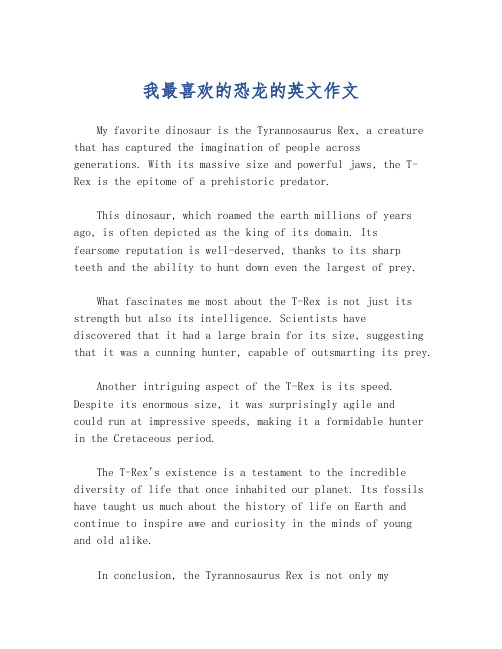
我最喜欢的恐龙的英文作文My favorite dinosaur is the Tyrannosaurus Rex, a creature that has captured the imagination of people across generations. With its massive size and powerful jaws, the T-Rex is the epitome of a prehistoric predator.This dinosaur, which roamed the earth millions of years ago, is often depicted as the king of its domain. Itsfearsome reputation is well-deserved, thanks to its sharpteeth and the ability to hunt down even the largest of prey.What fascinates me most about the T-Rex is not just its strength but also its intelligence. Scientists havediscovered that it had a large brain for its size, suggesting that it was a cunning hunter, capable of outsmarting its prey.Another intriguing aspect of the T-Rex is its speed. Despite its enormous size, it was surprisingly agile andcould run at impressive speeds, making it a formidable hunter in the Cretaceous period.The T-Rex's existence is a testament to the incredible diversity of life that once inhabited our planet. Its fossils have taught us much about the history of life on Earth and continue to inspire awe and curiosity in the minds of young and old alike.In conclusion, the Tyrannosaurus Rex is not only myfavorite dinosaur but also a symbol of the ancient world's power and majesty. Its legacy lives on in the hearts andminds of those who marvel at the wonders of the natural world.。
恐龙.doc
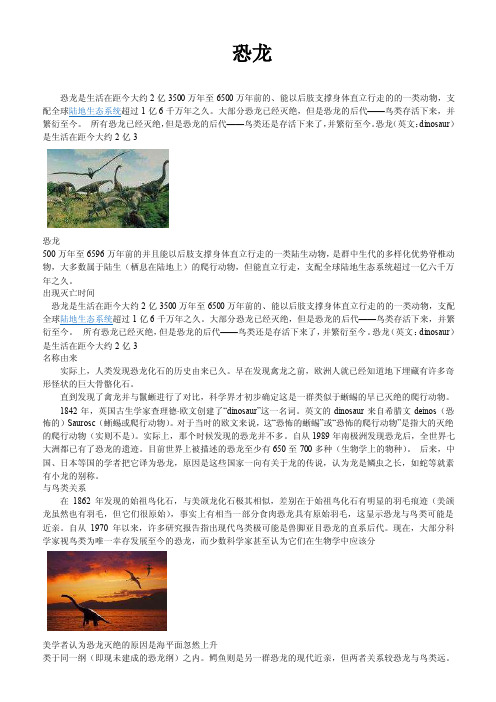
恐龙恐龙是生活在距今大约2亿3500万年至6500万年前的、能以后肢支撑身体直立行走的的一类动物,支配全球陆地生态系统超过1亿6千万年之久。
大部分恐龙已经灭绝,但是恐龙的后代——鸟类存活下来,并繁衍至今。
所有恐龙已经灭绝,但是恐龙的后代——鸟类还是存活下来了,并繁衍至今。
恐龙(英文:dinosaur)是生活在距今大约2亿3恐龙500万年至6596万年前的并且能以后肢支撑身体直立行走的一类陆生动物,是群中生代的多样化优势脊椎动物,大多数属于陆生(栖息在陆地上)的爬行动物,但能直立行走,支配全球陆地生态系统超过一亿六千万年之久。
出现灭亡时间恐龙是生活在距今大约2亿3500万年至6500万年前的、能以后肢支撑身体直立行走的的一类动物,支配全球陆地生态系统超过1亿6千万年之久。
大部分恐龙已经灭绝,但是恐龙的后代——鸟类存活下来,并繁衍至今。
所有恐龙已经灭绝,但是恐龙的后代——鸟类还是存活下来了,并繁衍至今。
恐龙(英文:dinosaur)是生活在距今大约2亿3名称由来实际上,人类发现恐龙化石的历史由来已久。
早在发现禽龙之前,欧洲人就已经知道地下埋藏有许多奇形怪状的巨大骨骼化石。
直到发现了禽龙并与鬣蜥进行了对比,科学界才初步确定这是一群类似于蜥蜴的早已灭绝的爬行动物。
1842年,英国古生学家查理德·欧文创建了“dinosaur”这一名词。
英文的dinosaur来自希腊文deinos(恐怖的)Saurosc(蜥蜴或爬行动物)。
对于当时的欧文来说,这“恐怖的蜥蜴”或“恐怖的爬行动物”是指大的灭绝的爬行动物(实则不是)。
实际上,那个时候发现的恐龙并不多。
自从1989年南极洲发现恐龙后,全世界七大洲都已有了恐龙的遗迹。
目前世界上被描述的恐龙至少有650至700多种(生物学上的物种)。
后来,中国、日本等国的学者把它译为恐龙,原因是这些国家一向有关于龙的传说,认为龙是鳞虫之长,如蛇等就素有小龙的别称。
与鸟类关系在1862年发现的始祖鸟化石,与美颌龙化石极其相似,差别在于始祖鸟化石有明显的羽毛痕迹(美颌龙虽然也有羽毛,但它们很原始),事实上有相当一部分食肉恐龙具有原始羽毛,这显示恐龙与鸟类可能是近亲。
我们要去挖恐龙阅读感想
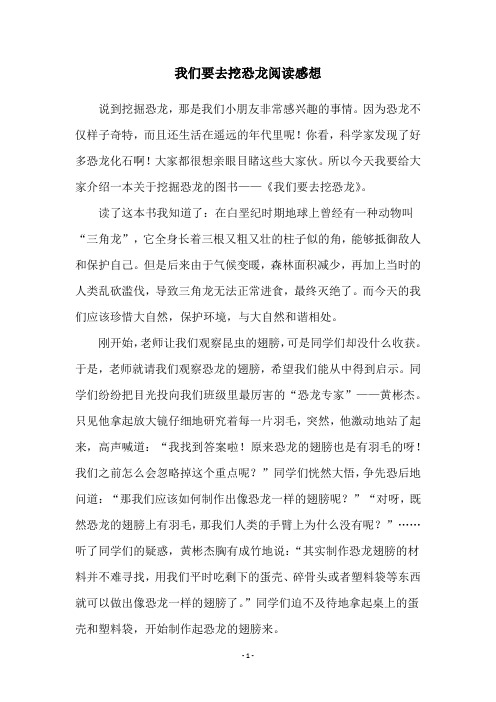
我们要去挖恐龙阅读感想
说到挖掘恐龙,那是我们小朋友非常感兴趣的事情。
因为恐龙不仅样子奇特,而且还生活在遥远的年代里呢!你看,科学家发现了好多恐龙化石啊!大家都很想亲眼目睹这些大家伙。
所以今天我要给大家介绍一本关于挖掘恐龙的图书——《我们要去挖恐龙》。
读了这本书我知道了:在白垩纪时期地球上曾经有一种动物叫“三角龙”,它全身长着三根又粗又壮的柱子似的角,能够抵御敌人和保护自己。
但是后来由于气候变暖,森林面积减少,再加上当时的人类乱砍滥伐,导致三角龙无法正常进食,最终灭绝了。
而今天的我们应该珍惜大自然,保护环境,与大自然和谐相处。
刚开始,老师让我们观察昆虫的翅膀,可是同学们却没什么收获。
于是,老师就请我们观察恐龙的翅膀,希望我们能从中得到启示。
同学们纷纷把目光投向我们班级里最厉害的“恐龙专家”——黄彬杰。
只见他拿起放大镜仔细地研究着每一片羽毛,突然,他激动地站了起来,高声喊道:“我找到答案啦!原来恐龙的翅膀也是有羽毛的呀!我们之前怎么会忽略掉这个重点呢?”同学们恍然大悟,争先恐后地问道:“那我们应该如何制作出像恐龙一样的翅膀呢?”“对呀,既然恐龙的翅膀上有羽毛,那我们人类的手臂上为什么没有呢?”……听了同学们的疑惑,黄彬杰胸有成竹地说:“其实制作恐龙翅膀的材料并不难寻找,用我们平时吃剩下的蛋壳、碎骨头或者塑料袋等东西就可以做出像恐龙一样的翅膀了。
”同学们迫不及待地拿起桌上的蛋壳和塑料袋,开始制作起恐龙的翅膀来。
发现恐龙英文作文100字
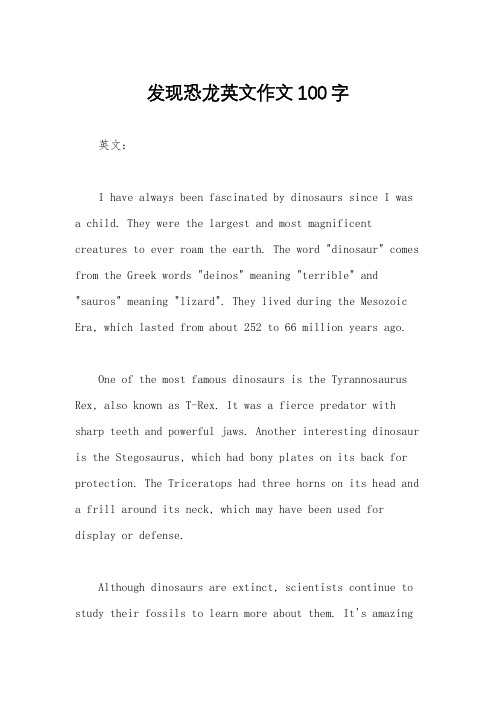
发现恐龙英文作文100字英文:I have always been fascinated by dinosaurs since I wasa child. They were the largest and most magnificent creatures to ever roam the earth. The word "dinosaur" comes from the Greek words "deinos" meaning "terrible" and "sauros" meaning "lizard". They lived during the Mesozoic Era, which lasted from about 252 to 66 million years ago.One of the most famous dinosaurs is the Tyrannosaurus Rex, also known as T-Rex. It was a fierce predator with sharp teeth and powerful jaws. Another interesting dinosaur is the Stegosaurus, which had bony plates on its back for protection. The Triceratops had three horns on its head and a frill around its neck, which may have been used for display or defense.Although dinosaurs are extinct, scientists continue to study their fossils to learn more about them. It's amazingto think that these creatures once walked the same ground that we do now.中文:我从小就一直被恐龙所吸引。
一种恐龙介绍英文作文

一种恐龙介绍英文作文英文:I would like to introduce the Tyrannosaurus rex, also known as T-Rex, a fearsome dinosaur that lived during the late Cretaceous period. T-Rex was one of the largest carnivorous dinosaurs, with a length of up to 40 feet and a height of about 15 feet. Its powerful jaws were lined with sharp, serrated teeth, and it had a strong, muscular body that allowed it to be a formidable predator.T-Rex was known for its keen sense of smell and excellent vision, which made it a skilled hunter. It was also believed to have been a fast runner, capable of reaching speeds of up to 25 miles per hour. Its long, powerful tail helped it maintain balance and agility while chasing its prey.One of the most fascinating things about T-Rex is its reputation as the "king of the dinosaurs." Its name, whichmeans "tyrant lizard king," reflects its status as a top predator in its ecosystem. T-Rex's fearsome appearance and impressive size have captured the imagination of people for generations, making it one of the most iconic dinosaurs in popular culture.Despite its ferocious reputation, T-Rex may have also exhibited some parental care. Fossilized nests and nesting grounds suggest that T-Rex females may have laid eggs and cared for their young, much like modern-day birds. This nurturing behavior adds a layer of complexity to our understanding of T-Rex as a species.Overall, T-Rex remains a symbol of power and strength in the world of paleontology, and its legacy continues to fascinate and inspire people of all ages.中文:我想介绍一下霸王龙,也被称为T-Rex,它是一种生活在晚白垩纪时期的可怕恐龙。
收集恐龙的资料作文英语
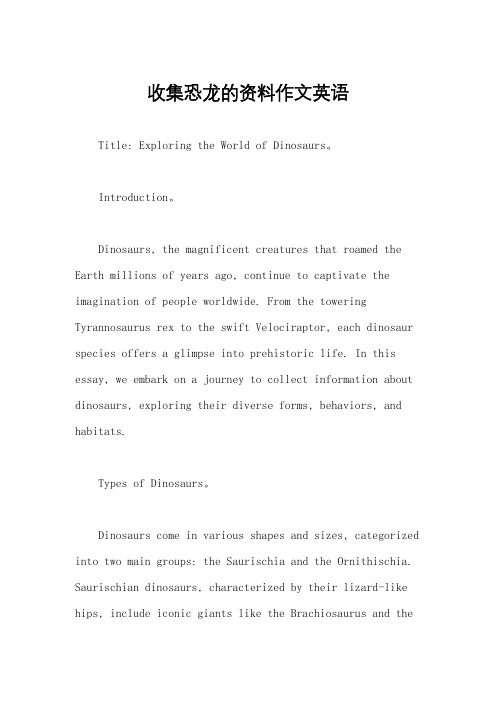
收集恐龙的资料作文英语Title: Exploring the World of Dinosaurs。
Introduction。
Dinosaurs, the magnificent creatures that roamed the Earth millions of years ago, continue to captivate the imagination of people worldwide. From the towering Tyrannosaurus rex to the swift Velociraptor, each dinosaur species offers a glimpse into prehistoric life. In this essay, we embark on a journey to collect information about dinosaurs, exploring their diverse forms, behaviors, and habitats.Types of Dinosaurs。
Dinosaurs come in various shapes and sizes, categorized into two main groups: the Saurischia and the Ornithischia. Saurischian dinosaurs, characterized by their lizard-like hips, include iconic giants like the Brachiosaurus and thefearsome T. rex. Ornithischians, on the other hand, possess hips resembling those of birds and encompass a broad array of species, such as the Triceratops and the Stegosaurus. By understanding these classifications, we gain insight into the evolutionary history and anatomical diversity of dinosaurs.Habitats and Environments。
恐龙的资料
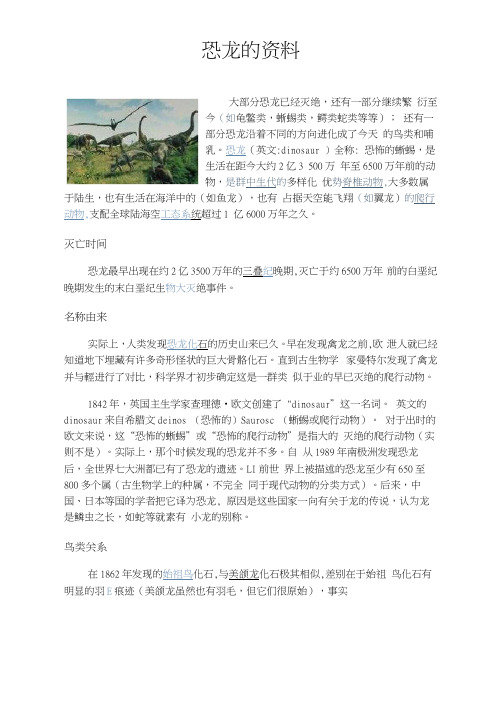
恐龙的资料大部分恐龙已经灭绝,还有一部分继续繁衍至今(如龟鳖类,蜥蜴类,鳄类蛇类等等);还有一部分恐龙沿着不同的方向进化成了今天的鸟类和哺乳。
恐龙(英文:dinosaur )全称: 恐怖的蜥蜴,是生活在距今大约2亿3 500万年至6500万年前的动物,是群中生代的多样化优势脊椎动物,大多数属于陆生,也有生活在海洋中的(如鱼龙),也有占据天空能飞翔(如翼龙)的爬行动物,支配全球陆海空工态系统超过1 亿6000万年之久。
灭亡时间恐龙最早出现在约2亿3500万年的三叠纪晚期,灭亡于约6500万年前的白垩纪晚期发生的末白垩纪生物大灭绝事件。
名称由来实际上,人类发现恐龙化石的历史山来已久。
早在发现禽龙之前,欧泄人就已经知道地下埋藏有许多奇形怪状的巨大骨骼化石。
直到古生物学家曼特尔发现了禽龙并与輕进行了对比,科学界才初步确定这是一群类似于业的早已灭绝的爬行动物。
1842年,英国主生学家查理德•欧文创建了"dinosaur”这一名词。
英文的dinosaur来自希腊文deinos (恐怖的)Saurosc (蜥蜴或爬行动物)。
对于出时的欧文来说,这“恐怖的蜥蜴”或“恐怖的爬行动物”是指大的灭绝的爬行动物(实则不是)。
实际上,那个时候发现的恐龙并不多。
自从1989年南极洲发现恐龙后,全世界七大洲都已有了恐龙的遗迹。
LI前世界上被描述的恐龙至少有650至800多个属(古生物学上的种属,不完全同于现代动物的分类方式)。
后来,中国、日本等国的学者把它译为恐龙, 原因是这些国家一向有关于龙的传说,认为龙是鳞虫之长,如蛇等就素有小龙的别称。
鸟类关系在1862年发现的始祖鸟化石,与美颌龙化石极其相似,差别在于始祖鸟化石有明显的羽E痕迹(美颌龙虽然也有羽毛,但它们很原始),事实上有相当一部分食肉恐龙具有原始羽毛,这显示恐龙与軽可能是近亲。
自从1970年以来,许多研究报告指出现代鸟类极可能是豊腔亚11恐龙的直系后代。
现在,大部分科学家视鸟类为唯一幸存发展至今的恐龙,而少数科学家甚至认为它们在生物学中应该分美学者认为恐龙灭绝的原因是海平面忽然上升类于同一纲(即现未建成的恐龙纲)之内。
恐龙种类中英文对照dinosaur flashcards

恐龙种类中英文对照dinosaur flashcards 恐龙种类中英文对照dinosaur flashcards1、Tyrannosaurus rex科学名称: Tyrannosaurus rex英文名: Tyrannosaurus rex特征: 大型食肉恐龙,拥有强壮的后肢和巨大的颌骨,以肉食为主,被称为“霸王龙”。
2、Velociraptor科学名称: Velociraptor英文名: Velociraptor特征: 中型肉食性恐龙,拥有锐利的爪子和敏捷的动作,以群体狩猎为主。
3、Brachiosaurus科学名称: Brachiosaurus英文名: Brachiosaurus特征: 大型植食性恐龙,拥有长颈和长尾巴,是已知体型最大的陆地动物之一。
4、Stegosaurus科学名称: Stegosaurus英文名: Stegosaurus特征: 大型植食性恐龙,拥有背部特征性的大型骨刺和装饰性的平板尾巴。
5、Triceratops科学名称: Triceratops英文名: Triceratops特征: 大型植食性恐龙,拥有三角形的头盾和两只长角,是最著名且最晚出现的角龙类。
6、Ankylosaurus科学名称: Ankylosaurus英文名: Ankylosaurus特征: 大型植食性恐龙,拥有坚硬的外骨甲和锤状的尾巴,用于自卫。
7、Spinosaurus科学名称: Spinosaurus英文名: Spinosaurus特征: 大型肉食性恐龙,拥有大型的脊椎帆和长而突出的、类似于鱼类的头部。
8、Pteranodon科学名称: Pteranodon英文名: Pteranodon特征: 大型飞行恐龙,拥有巨大的翅膀和尖喙,能够飞行并捕食空中的小型动物。
9、Diplodocus科学名称: Diplodocus英文名: Diplodocus特征: 大型植食性恐龙,拥有长颈和长尾巴,是已知最长的恐龙之一。
- 1、下载文档前请自行甄别文档内容的完整性,平台不提供额外的编辑、内容补充、找答案等附加服务。
- 2、"仅部分预览"的文档,不可在线预览部分如存在完整性等问题,可反馈申请退款(可完整预览的文档不适用该条件!)。
- 3、如文档侵犯您的权益,请联系客服反馈,我们会尽快为您处理(人工客服工作时间:9:00-18:30)。
Here Comes the Dinosaur hunters English dinosaur hunters discovered many new kinds of dinosaurs. Their discoveries made newspaper headlines. People wanted to know everything about these extinct giants.Artists painted pictures of what they thought dinosaurs looked like. Sculptors built life-size dinosaur statues.For New Year’s Eve in 1853, a scientist sent party invitations to other scientists. When the guests showed up, they found a table set for twenty-two people inside the body cavity of an almost-finished statue of an Iguanodon!Words of the giant fossil bones spread quickly. By the 1850s, dinosaur fever had hit America, too. At this time, new railroad beds were being dug out west. Prospectors were digging for gold in California and Colorado. With all that digging going on, fossils were uncovered nearly every day. The western United States was a dinosaur hunter’s dream.Like cowboys, early dinosaur hunters in America were rugged. They loved adventure. They carried chisels and rock hammers. They also carried rifles and bowie knives. The West was a wild and dangerous place.Dinosaur hunters often lived off the land. They shot their food every day. They had to know where to find water in the desert. They drove stubborn pack mules and clumsy wagons.Dinosaur hunters called the place they worked a “dig”. they had to figure out how to get huge bones out of solid rock with just picks, shovels and ropes. When they dug up bones, dinosaur hunters sometimes wrapped them in cloth or in flour sacks. They put the bones in their wagons or packed them onto the backs of their mules. Then they headed for the nearest railroad. They shipped the bones back east to fossil collectors and museums.Two of the most famous bone collectors were Dr.Edward Cope and Dr.Othniel Marsh. These two paleontologists started out as friends. But soon they became enemies. Each one wanted all the dinosaur bones for himself.Both Cope and Marsh found lots of bones. Each one wanted to be the first to show off his dinosaur skeletons. When Cope found the bones of an Elasmosaurus (ih-LAS-muh-SAW-rus), he was in such a hurry to show off the skeleton that he put the head on the tail end! Marsh made sure that everyone knew about Cope’s big mistake. But later, he made one of his own. He put the skull of another dinosaur on top of an Apatosaurus(ah-PAT-uh-SAW-rus) skeleton. He called this “new” dinosaur Brontosaurus (BRON-tuh-SAW-rus). his mistakes was not corrected for almost one hundred years.In the 1870s, railroad workers began finding big bones at Como Bluff, Wyoming. The place was so loaded with fossilsthat one trapper built himself a cabin out of dinosaur bones.Cope and Marsh heard about these bones. Both men headed west and set up digs. Cope accused Marsh of stealing bones from his dig. Marsh wanted to make sure that Cope didn’t get any of his fossils. So he had his workers set up dynamite—and he blew up his own dig!Other scientists were ashamed of the way Cope and Marsh fought. They thought it gave paleontologists a bad name. But they had to admit one thing. The “bone war”led to the discovery of tons and tons of dinosaur bones.Marsh and his team of dinosaur hunters were the first to find Apatosaurus, Stegosaurus (STEG-uh-SAW-rus), and Triceratops (try-SAIR-uh-tops). If you visit Yale University’s Peabody Museum, you can see Marsh’s dinosaurs. You can see many of Cope’s dinosaurs at the American Museum of Natural History, in New York City.Hunting GiantsUnlike fossil hunters a hundred years ago, today’s dinosaur hunters have modern tools. They drive trucks instead of pack mules and wagons. Sometimes computers can help them discover where big bones are buried. But the thrill of finding dinosaur bones hasn’t changed. And neither has the long, hard work.When dinosaur hunters find a place to dig, they make camp. In hot places, they may build a wooden roof over the spot where they will dig. The roof protects the fossils that are exposed during digging. It shades the dinosaur hunters too.On some digs, dinosaur hunters use a back hoe to remove layers of rock and dirt above the fossils. Once they get close to a bone, they switch to handheld tolls such as chisels, awls, and hammers. Sometimes they even use dental picks. Dinosaur hunters have to be careful. One wrong move can shatter a huge dinosaur bone.Sometimes dinosaur hunters will dig out a big chunk of rock with fossilized bones in it. They don’t chip away the rock around the bones. Instead, the rock is left around the fossils to help protect them/ the entire rock is wrapped in paper towels and covered with plaster. Then it is put in a crate and sent to a museum.Other times, bones are taken out of the rock right at a dig. But dinosaur hunters don’t hurry. They take pictures of the bones justas they are in the ground. Sometimes they make drawings, too. Then each bone is numbered. All this work will help later, when a skeleton is put together again in a museum laboratory.Next, dinosaur hunters pour a type of glue on each bone as it lies cradled in the rock. The glue hardened the bones. When the glue is dry, the bone can usually be taken safely out of the rock.Little bones can be wrapped in foil and packed in boxes. But bigger bones need more protection. First, they are covered with a thin wrapping, like tissue paper, paper towels, or foil. Then burlap strips are soaked in wet plaster.These strips are wrapped around the bones. The wrapping keeps the plaster from sticking to the bones. The plaster dries into a hard cast, like the kind doctors make for broken bones. These casts, or jackets, protect big bones while they are being shipped.Rally big dinosaur bones can be really big problems for dinosaur hunters. If large trucks get close to a dig, dinosaur hunters can use powerful winches to lift the bones out of the ground. This makes it possible for today’s dinosaur hunters to collect bigger dinosaur bones than ever before. And for many years, when it came to hunting BIG dinosaurs, nobody beat Dinosaur Jim.Dinosaur hunters like Dinosaur Jim find fossils in all sorts of ways. Sometimes people call them up with tips. An oil field worker might report that she’s seen some big bones buried in the sand. Aquarry digger might tell them he’s uncovered a giant skull. A miner might phone to say that while he was digging for coal, he found a huge backbone. And if a call comes? A dinosaur hunter is on the way!Dinosaur Jim hunted giant dinosaurs outside. He hunted them inside museums, too. Once, while poking around a storeroom, Dinosaur Jim discovered a huge arm bone. It was the biggest one he’d ever seen. A tag said that the bone had been found in Colorado. Were more of this big dinosaur’s bones buried in the same place. Dinosaur Jim headed to Colorado to find out.Dinosaur Jim started digging. His hunch was right. He and his crew dug up part of a skeleton of the largest dinosaur ever found.Until Dinosaur Jim’s discovery, the forty-foot-tall Brachiosaurus (BRACK-ee-uh-SAW-rus) was the biggest known dinosaur. But Dinosaur Jim’s new dinosaur was even bigger. It would have been 120 feet long! That’s why he called it Supersaurus.but Dinosaur Jim’s discovery wasn’t the biggest dinosaur. In 1991, hikers in New Mexico found an even bigger dinosaur. They saw a long line of huge white rock poking out of the earth. The rocks turned out to be the bones of a huge dinosaur’s tail. The hikers called a dinosaur hunter, Dr. David Gillette. He named this new dinosaur Seimosaurus (SIZE-muh-SAW-rus), or “earthshaking lizard”.Then , in 1993, a shop rancher in Argentina saw what looked like a log made of stone. Two South American dinosaur hunters came to check it out. The log turned out to be a bone of an even bigger dinosaur. They named it Argentinosaurus.But is it the biggest? Or were there even bigger dinosaur roaming the earth millions of years ago? Absolutely. Their bones are still waiting for someone to find them.。
